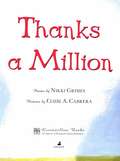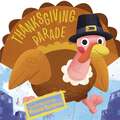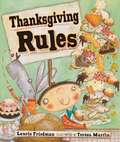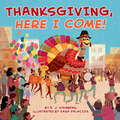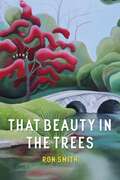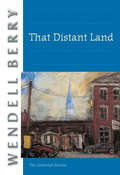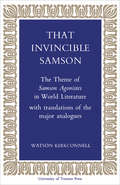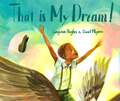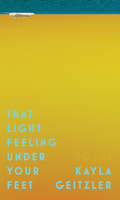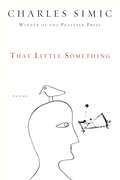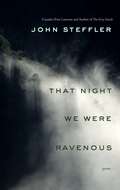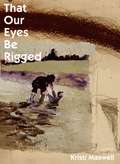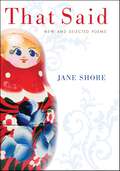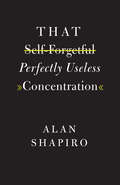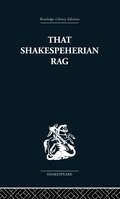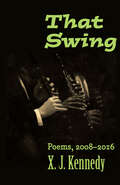- Table View
- List View
Thackeray in Time: History, Memory, and Modernity (The Nineteenth Century Series)
by Richard Salmon Alice CrossleyAn intense fascination with the experience of time has long been recognised as a distinctive feature of the writing of William Makepeace Thackeray (1811–1863). This collection of essays, however, represents the first sustained critical examination of Thackeray's 'time consciousness' in all its varied manifestations. Encompassing the full chronological span of the author's career and a wide range of literary forms and genres in which he worked, Thackeray in Time repositions Thackeray's temporal and historical self-consciousness in relation to the broader socio-cultural contexts of Victorian modernity. The first part of the collection focusses on some of the characteristic temporal modes of professional authorship and print culture in the mid-nineteenth century, including periodical journalism and the Christmas book market. Secondly, the volume offers fresh approaches to Thackeray's acknowledged status as a major exponent of historical fiction, reconsidering questions of historiography and the representation of place in such novels as Vanity Fair and Henry Esmond. The final part of the collection develops the central Thackerayan theme of memory within four very different but complementary contexts. Thackeray's absorption by memories of childhood in later life leads on to his own subsequent memorialisation by familial descendants and to the potential of digital technology for preserving and enhancing Thackeray's print archive in the future, and finally to the critical legacy perpetuated by generations of literary scholars since his death.
Thalia Delighting in Song
by Bonnie Maclachlan Emmet I. RobbinsEmmet I. Robbins earned an international reputation as a scholar of ancient Greek poetry, possessing a broad cultural background and a command of many languages that allowed him to present sensitive and informed readings of poets from Homer to the tragedians. Thalia Delighting in Song assembles for the first time his work from 1975 through 1999, reflecting his close reading of the Greek texts and his firm grasp of their literary, historical and mythological contexts.Among the essays included in this volume are important reflections on the poetry of Homer, Alcman, Sappho, Pindar and Aeschylus. Also featured are Robbins' writings that situate Greek texts in their wider contexts, comparing Greek poetry and modern opera, for example, or assessing the enduring influence of myth in the Indo-European traditions, accounting for links between Greek literature and the poetry, sagas and songs of several other cultures. Thalia Delighting in Song ensures that the next generation of Classicists will continue to benefit from the insights of one of the foremost scholars in the field.
Thamizh Veeranilaik Kavithai
by K. Kailasapathy K. V. BalasubramanianThis book is a translation of veteran author K.Kailasapathy's 'Tamil heroic Poetry' , that is till date a very important work in the field of Research.It introduced 'Sanga Kala Ilakkiyam' to the rest of the world as well.
Thank You -- You're Welcome
by Louis SlobodkinManners are so important and Jimmy learns how important the words thank you and you're welcome are. Jimmy gets lots of opportunities to learn the value mad finds how happy it makes him feel in this rhyming story with limited picture descriptions.
Thank You, Gracias: A Bilingual Lift-the-Flap Book
by Susie JaramilloFrom the Emmy-nominated, award-winning bilingual preschool series Canticos, comes Thank You, Gracias, a lift-the-flap board book about giving thanks written in rhyming English and Spanish text, perfect for fans of Amor is to Love You.Sing and learn about what it means to give thanks, in both English and Spanish. Thank You, Gracias is full of bright, cheerful art featuring the Little Chickies and other favorite Canticos characters, and engaging lift-the-flaps. This board book is a great way to make learning and singing with your little ones special and unique in not one, but two languages.
Thanksgiving Parade
by Price Stern SloanGet excited about the Thanksgiving Day parade! Through rhyming text, this adorable book captures some of the best features of the parade, as seen through the eyes of a child.
Thanksgiving Poems
by Myra Cohn LivingstonSome of the poems were written for this collection, others are from well-known sources of poetry--Navajo and Osage writings, The King James version of the Holy Bible. There are poems poking fun at people who stuff themselves, and poems singing praises to God. Other selections by this American poet are available in this library.
Thanksgiving Rules
by Laurie FriedmanI officially command you to eat EVERYTHING you see! Percy knows just what to do to get the most out of this delicious holiday. And so will you if you follow ten simple rules. From "the early bird gets the turkey" to "life is sweeter when you eat sweets," his rules will help you eat your way through the big meal. But is there more to Thanksgiving than stuffed turkey and sweet potatoes with marshmallows? See how Percy discovers the true recipe for a perfect Thanksgiving holiday. Ages 5-9
Thanksgiving, Here I Come! (Here I Come!)
by D.J. SteinbergCelebrate Thanksgiving with a collection of festive poems from the author of Kindergarten, Here I Come!It's Thanksgiving time and everyone is getting into the holiday spirit! From making stuffing with Grandma to playing Plymouth Rock in a school skit, these poems from author D. J. Steinberg cover the heartwarming and hilarious moments families share on this special occasion. Readers are sure to be thankful for this book!
Thanniir Desam of Vairamuthu-Part I
by Kavignar VairamuthuThe first of two parts book is a modern poetry (Pudhu Kavidhai) about adventures of Sea in a poetic novel format.
Thanniir Desam of Vairamuthu-Part II
by Kavignar VairamuthuThe second part of the two parts book is a modern poetry (Pudhu Kavidhai) about adventures of Sea in a poetic novel format.
That Beauty in the Trees: Poems (Southern Messenger Poets)
by Ron SmithMoving effortlessly from Virginia to Italy and beyond, Ron Smith’s new volume responds with a range of emotions from humor to horror and with a variety of forms from the sonnet to visually expressive organic shapes. The book’s forty-three pieces gather themselves into three flights that hover above and touch down among the politics of memory and the psychology of beauty. With inspiration drawn from memoir, myth, history, fiction, and the visual arts, That Beauty in the Trees presents, ponders, and sometimes judges the actions, fates, and aesthetics of not only the author’s friends and family but also legendary and historical figures, including Achilles, Catullus, George Washington, Edgar Allan Poe, H.D., Ezra Pound, and many more.
That Distant Land: The Collected Stories (Port William Ser.)
by Wendell BerryOriginally published in 2005, That Distant Land brings together twenty–three stories from the Port William Membership. Arranged in their fictional chronology, the book is not an anthology so much as it is a coherent temporal mapping of this landscape over time, revealing Berry’s mastery of decades of the life lived alongside this clutch of interrelated characters bound by affection and followed over generations.This volume combines the stories found in The Wild Birds (1985), Fidelity (1992), and Watch with Me (1994), together with a map and a charting of the complex and interlocking genealogies.
That Invincible Samson: The Theme of Samson Agonistes in World Literature
by Watson KirkconnellThis work examines the more than one hundred analogues of Samson Agonistes, about half of them written earlier than Milton's drama. The author has gone back in every instance to primary sources, and examined all treatments of Milton's theme, in all languages, for their intrinsic interest and merit. While he has not entirely omitted a discussion of source relationships, his concern here has been chiefly with analogues. In Part I of the book the author compares five pre-Miltonic works, which he has translated, in whole or in part, from the original Latin, Dutch, and Italian. In Part II, a descriptive catalogue, he comments on the significance, to Miltonists and to the general reader, of the analogues. He traces the purposes beyond mere theatre in the different versions of the play: versions prior to 1670 contain many overtones of personal, national, or theological significance, while, after 1671, there is a rapid shift away from religious or moral presentation to a more strictly theatrical entertainment. Dr. Kirkconnell believes that this shift in interest has obscured from most of the critics of later centuries the tone and tradition of this great drama. The nineteenth and twentieth centuries have seen dozens of versions of the old play theme, nearly all of them wholly disregarding any inner drama of the spirit, and stressing extrovert aspects of Strength, Beauty, and Sex. As a whole, the analogues will reveal the variety that playwrights have found possible in the ancient theme. The author concludes that Milton's treatment is the noblest ever written, surpassing all others in literary quality and in the nature of the dramatic conflict it describes.
That Is My Dream!: A picture book of Langston Hughes's "Dream Variation"
by Langston Hughes&“Dream Variation,&” one of Langston Hughes's most celebrated poems, about the dream of a world free of discrimination and racial prejudice, is now a picture book stunningly illustrated by Daniel Miyares, the acclaimed creator of Float. To fling my arms wide In some place of the sun, To whirl and to dance Till the white day is done…. Langston Hughes's inspiring and timeless message of pride, joy, and the dream of a better life is brilliantly and beautifully interpreted in Daniel Miyares's gorgeous artwork. Follow one African-American boy through the course of his day as the harsh reality of segregation and racial prejudice comes into vivid focus. But the boy dreams of a different life—one full of freedom, hope, and wild possibility, where he can fling his arms wide in the face of the sun. Hughes's powerful vision, brought joyously to life by Daniel Miyares, is as relevant—and necessary—today as when it was first written.
That Light Feeling Under Your Feet (Crow Said Poetry)
by Kayla GeitzlerFinalist for The Fiddlehead Poetry Book Prize at the New Brunswick Book Awards!Shortlisted for the Robert Kroetsch Award for Poetry at the 2019 Alberta Book Publishing Awards!That Light Feeling Under Your Feet plunges headfirst into the surreal and slogging world of cruise ship workers. These masterfully crafted poems challenge perpetuating colonial and class relations, as well as the hedonistic lifestyle attributed to the employees of these floating resorts. Kayla Geitzler’s debut collection interprets isolation, alienation, racism, and assimilation into the margins as inevitable consequences for the seafaring workforce of the most profitable sector of the tourism industry.Exploring the liminal space between labour and leisure, the poems in That Light Feeling Under Your Feet are at once buoyant and weighty, with language that cuts like a keel through the sea.
That Light, All at Once: Selected Poems (The Margellos World Republic of Letters)
by Jean-Paul de DadelsenPoetry in a time of upheaval Equal parts dramatic and symphonic, the poetry of Jean-Paul de Dadelsen provides acute insight into the European consciousness of the first half of the twentieth century. With energetic innovation and imaginative depth, Dadelsen extols the somber beauty of his Alsatian homeland, grapples with the elusiveness of meaning, and decries religion&’s futile attempts to speak to a continent ravaged by fascism and war. His is an acerbic and humane assessment of French and European identity that draws on the past and imagines the future, while remaining firmly rooted in the present. In these poems, Dadelsen modulates himself in dramatic monologue, exploring a mosaic of voices to form a composite portrait of the postwar landscape. Inhabiting such characters as King Solomon, Johann Sebastian Bach, provincial French women, and a Hungarian resistant in the 1956 uprising, the poems in this new bilingual collection offer an inside look at the shifting cultural topography of midcentury Europe, forged in the war that reshaped our understanding of the human condition.
That Little Something: Poems
by Charles SimicIn his nineteenth collection, Charles Simic, the poet of the vaguely ominous sound and the disturbing, potentially significant image, moves closer to the dark heart of history and human behavior.
That Night We Were Ravenous
by John StefflerA beautiful new edition of the award-winning collection from Canada's new Poet Laureate.Newfoundland-born poet John Steffler is one of this country's most accomplished writers. Recently named Canada's national poet, he is the author of The Grey Islands (poems) and the award-winning novel The Afterlife of George Cartwright, both of which have become classics in our time.That Night We Were Ravenous is Steffler's most recent book of new poetry. In this extraordinary gathering of poems, he follows the trajectory of some of his earlier work with poems situated in Newfoundland's coves, on trails, and in communities that testify to the pure bite and edge of this terrain. Other poems in the later sections of the book, more intimate, are set in Southern Ontario and Greece.This is poetry that captures the imagination and activates the heart. Simply by looking through Steffler's eyes, we come away with an enlarged sense of the natural world on the one hand, and of our own humanity on the other.From the Trade Paperback edition.
That Our Eyes Be Rigged
by Kristi MaxwellPlayful, penetrating, and often operating by aural law, the poems in That Our Eyes Be Rigged take shape as one word quickly transforms into another via sonic slippages. These fluid transformations simultaneously reveal the worlds within a word and build correspondences between unlikely terms—highlighting the very notion of exchange between the linguistic and the physical realm. Maxwell’s poems are both generous and demanding. While the operating intelligence behind the poems incessantly questions how one makes a life in language (and vice versa), the poems themselves enact arrangements that might make such pathways possible. These restless and inventive poems provide feats of language that lead us to agree with Maxwell’s speaker when she says: Our awe is our confession.
That Said: New and Selected Poems
by Jane Shore“Jane Shore is the poet of little ambushes, moments that hold us hostage, moments when we come to life.” — Julia AlvarezSince Robert Fitzgerald praised Eye Level, Jane Shore’s 1977 Juniper Prize–winning first collection, for its “cool but venturesome eye,” her work has continued to receive the highest accolades and attention from critics and fellow poets. That Said: New and Selected Poems extends Shore’s lifelong, vivid exploration of memory—her childhood in New Jersey, her Jewish heritage, her adult years in Vermont. Shore’s devotion to her familiar coterie of departed parents, aunts, uncles, and friends passionately subscribes to Sholem Aleichem’s dictum that “eternity resides in the past.”United States Poet Laureate W. S. Merwin wrote, “Shore’s characters emerge with an etched clarity . . . She performs this summoning with a language of quiet directness, grace and exactness, clear and without affectations.” And while there is no “typical” Jane Shore poem, what unifies them is her bittersweet introspection, elegant restraint, provocative autobiography, and on every page a magnetic readability.
That Self-Forgetful Perfectly Useless Concentration
by Alan ShapiroMore than a gathering of essays, That Self-Forgetful Perfectly Useless Concentration is part memoir, part literary criticism, and an artful fusion of the two. It is an intimate portrait of a life in poetry that only Alan Shapiro could have written. In this book, Shapiro brings his characteristic warmth, humor, and many years as both poet and teacher to bear on questions surrounding two preoccupations: the role of conventions--of literary and social norms--in how we fashion our identities on and off the page, and how suffering both requires and resists self-expression. He sketches affectionate portraits of his early teachers, revisits the deaths of his brother and sister, and examines poems that have helped him navigate troubled times. Integrating storytelling and literary analysis so seamlessly that art and life become extensions of each other, Shapiro embodies in his lively prose the very qualities he celebrates in the poems he loves. Brimming with wit and insight, this is a book for poets, students and scholars of poetry, teachers of literature, and everyone who cares about the literary arts and how they illuminate our personal and public lives.
That Shakespeherian Rag: Essays on a critical process
by Terence HawkesFirst published in 1986. This collection of essays focuses on the ways in which our society 'processes' Shakespeare and the purposes for which this seems to be done. The case is made by examining the work of four highly influential critics: A C Bradley, Walter Raleigh, T S Eliot and John Dover Wilson. Terence Hawkes asks whether, beyond the readings to which the plays may be subjected, there lies any final, authoritative or essential meaning to which we can ultimately turn, concluding that jazz music offers the most fruitful model for twentieth-century criticism.
That Swing: Poems, 2008–2016 (Johns Hopkins: Poetry and Fiction)
by X. J. KennedyThe latest rollicking verse from award-winning poet X. J. Kennedy.In this, his ninth book of poetry, lyric master X. J. Kennedy regales his readers with engaging rhythm fittingly signaled by the book’s title, which echoes Duke Ellington’s jazz classic "It Don’t Mean a Thing (If It Ain’t Got That Swing)." Kennedy’s poems, infused with verve and surprise, are by turns irresistibly funny and sharply insightful about life in America.Some poems are personal recollections of childhood and growing up, as in "My Mother Consigns to the Flames My Trove of Comic Books." "Thomas Hardy’s Obsequies" tells the bizarre true account of the literary giant’s burial. Other poems portray memorable characters, from Jane Austen ("Jane Austen Drives to Alton in Her Donkey Trap") to a giant land tortoise ("Lonesome George") to a slow-witted man hired to cook for a nudist colony ("Pudge Wescott"). Kennedy is a storyteller of the first order, relating tales of travel to far-reaching places, from the Galápagos Islands and Tiananmen Square to the hectic back streets of Bamako, Mali. This wise and clever book is rounded out with adept translations of work by Charles Baudelaire, Stéphane Mallarmé, Arthur Rimbaud, and others.



